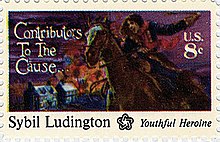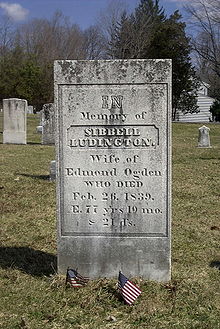Sybil Ludington

Sybil Ludington (* 1761 in Dutchess County , † 1839 in Unadilla , New York ) was the eldest of twelve children of Henry Ludington and a person in the American Revolutionary War . On the night of April 26, 1777, she was putting her siblings to bed when the family received news that the British had begun to burn down Danbury , about 25 miles away . Her father's troops were scattered over a larger area, and Sybil, then sixteen, convinced her father that he would let her ride out to alert her.
Between 9 p.m. and dawn she rode a distance of around 40 miles in the dark. "Muster at Ludington's," she urged the militia on the farms. That night she rode via Carmel to Mahopac , then to Kent Cliffs, and thence to Farmers Mills , where she started her way back home. She drove her horse Star with a stick and knocked on the doors, with her father's musket she defended herself against a highwayman. When she returned home drenched in the rain and exhausted, most of her father's 400 soldiers were ready to leave.
The men arrived too late to save Danbury, but at the beginning of the Battle of Ridgefield were able to force the Governor of the New York Colony, General William Tryon and his men to Long Island Sound . Sybil was later commended by General George Washington .
After the War of Independence, Sybil married the lawyer Edmund Ogden from Catskill in 1784. The marriage produced a son, Henry, whose son later founded Fort Riley in Kansas . Sybil lived in Unadilla until her death. She was buried next to her father in the Presbyterian Cemetery in Patterson , New York.
A statue of Sybil Ludington made by Anna Hyatt Huntington was erected near Carmel in 1961, with a smaller copy on the property of the Association of the Daughters of the American Revolution in Washington, DC and another in Danbury, Connecticut. The United States Postal Service commemorated Sybil Ludington in 1975 with a commemorative stamp in the four-part series Contributors to the Cause to mark the bicentenary of the founding of the United States.
The philosopher Martha Nussbaum reports from her childhood: “At that time I was completely captured by a children's book called Ride for Freedom . It was about a girl named Sybil Ludington […] I asked my parents if I could reenact their story in the basement and used various items that were kept there as horses. ”The story of Sybil Ludington had an enthusiasm for the American Revolution awakened in her.
Individual evidence
- ↑ Martha C. Nussbaum: Political Emotions. Why love is important for justice. Berlin 2014, p. 310.
Web links
- The American Storyteller Radio Journal
- Sybil Ludington Memorial in the database of Find a Grave (English)
- Sybil Ludington at HistoricPatterson.org (English)
| personal data | |
|---|---|
| SURNAME | Ludington, Sybil |
| BRIEF DESCRIPTION | Person in the US Revolutionary War |
| DATE OF BIRTH | 1761 |
| DATE OF DEATH | 1839 |
| Place of death | Unadilla , New York, United States |
